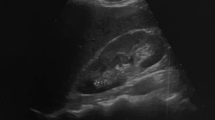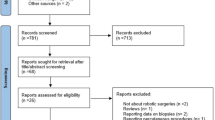Abstract
Fluoroscopy is essential in percutaneous nephrolithotomy (PCNL) but exposes patients and operating room staff to radiation. We investigated whether a low-dose (LD) protocol could reduce radiation exposure during fluoroscopy-guided access without compromising clinical outcomes. Patients undergoing PCNL with fluoroscopy-guided access at a tertiary care stone center between January 2019 and July 2021 were identified. Prior to September 3, 2020, the Philips Veradius C-arm’s default settings were used: standard per-frame dose, 15 pulses per second (PPS) frame rate. After this date, a low-dose protocol was used: reduced per-frame dose, reduced frame rate of 8 PPS for needle puncture and 4 PPS for all other steps. Clinical and radiographical data were retrospectively collected. The primary outcome was cumulative radiation dose. Secondary outcomes were stone-free status (SFS; defined as no fragments ≥ 2 mm) and complications. Multivariate regression analysis was performed. 100 patients were identified; 31 were in the LD group. The LD cohort was exposed to a significantly lower mean cumulative radiation dose of 11.68 mGy compared to 48.88 mGy (p < 0.0001). There were no differences in operative time, fluoroscopy time, stone burden, SFS, or complications. In a multivariable regression model adjusting for several variables, LD protocol was associated with lower radiation dose while skin-to-calyx-distance (STCD) was positively associated with cumulative radiation dose. Low-dose fluoroscopy and decreased frame rate during PCNL decreased radiation exposure fourfold without affecting SFS or complication rates.
Similar content being viewed by others
References
Scales CD, Smith AC, Hanley JM, Saigal CS (2012) Prevalence of kidney stones in the United States. Eur Urol 62:160–165. https://doi.org/10.1016/J.EURURO.2012.03.052
Assimos D, Krambeck A, Miller N (2016) Kidney Stones: Surgical Management Guideline - American Urological Association. In: Am. Urol. Assoc. https://www.auanet.org/guidelines/guidelines/kidney-stones-surgical-management-guideline. Accessed 25 Nov 2021
Clement CH, Stewart FA, Akleyev AV et al (2012) ICRP publication 118: ICRP statement on tissue reactions and early and late effects of radiation in normal tissues and organs-threshold doses for tissue reactions in a radiation protection context. Ann ICRP 41:1–322. https://doi.org/10.1016/j.icrp.2012.02.001
Vassileva J, Zagorska A, Basic D et al (2020) Radiation exposure of patients during endourological procedures: IAEA-SEGUR study. J Radiol Prot 40:1390–1405. https://doi.org/10.1088/1361-6498/abc351
Chi T, Masic S, Li J, Usawachintachit M (2016) Ultrasound guidance for renal tract access and dilation reduces radiation exposure during percutaneous nephrolithotomy. Adv Urol. https://doi.org/10.1155/2016/3840697
Zampini AM, Bamberger JN, Gupta K et al (2021) Factors affecting patient radiation exposure during prone and supine percutaneous nephrolithotomy. J Endourol 35:1448–1453. https://doi.org/10.1089/end.2020.0870
Bayne DB, Usawachintachit M, Tzou D et al (2018) Increasing body mass index steepens the learning curve for ultrasound-guided percutaneous nephrolithotomy. Urology 120:68–73. https://doi.org/10.1016/J.UROLOGY.2018.07.033
Jin W, Song Y, Fei X (2020) The pros and cons of balloon dilation in totally ultrasound-guided percutaneous nephrolithotomy. BMC Urol 20:1–7. https://doi.org/10.1186/S12894-020-00654-X/TABLES/3
Usawachintachit M, Tzou DT, Hu W et al (2017) X-ray–free ultrasound-guided percutaneous nephrolithotomy: how to select the right patient? Urology 100:38–44. https://doi.org/10.1016/J.UROLOGY.2016.09.031
Elkoushy MA, Shahrour W, Andonian S (2012) Pulsed fluoroscopy in ureteroscopy and percutaneous nephrolithotomy. Urology 79:1230–1235. https://doi.org/10.1016/J.UROLOGY.2012.01.027
Durutovic O, Dzamic Z, Milojevic B et al (2016) Pulsed versus continuous mode fluoroscopy during PCNL: safety and effectiveness comparison in a case series study. Urolithiasis 44:565–570. https://doi.org/10.1007/S00240-016-0885-6
Blair B, Huang G, Arnold D et al (2013) Reduced fluoroscopy protocol for percutaneous nephrostolithotomy: feasibility, outcomes and effects on fluoroscopy time. J Urol 190:2112–2116. https://doi.org/10.1016/J.JURO.2013.05.114
Acknowledgement
David Pogal, R.T.(R)(ARRT).
Funding
The authors received no financial support for the research, authorship, and/or publication of this article.
Author information
Authors and Affiliations
Contributions
GC, TC, SQ, and RJ wrote the main manuscript text. GC, TC, and RJ collected the data. CF ran statistics on the data. All authors interpreted the data. GC, TC, CF, and RJ prepared the tables with the data. All authors reviewed the manuscript.
Corresponding author
Ethics declarations
Conflict of interest
The authors disclose no financial or non-financial interests that are directly or indirectly related to the work submitted for publication.
Ethical approval
Ethical approval was waived by the local Ethics Committee of University of Rochester Medical Center in view of the retrospective nature of the study and all the procedures being performed were part of the routine care.
Additional information
Publisher's Note
Springer Nature remains neutral with regard to jurisdictional claims in published maps and institutional affiliations.
Rights and permissions
Springer Nature or its licensor (e.g. a society or other partner) holds exclusive rights to this article under a publishing agreement with the author(s) or other rightsholder(s); author self-archiving of the accepted manuscript version of this article is solely governed by the terms of such publishing agreement and applicable law.
About this article
Cite this article
Cheng, G., Campbell, T., Feng, C. et al. Low-dose fluoroscopy technique drastically decreases patient radiation exposure during percutaneous nephrolithotomy. Urolithiasis 51, 11 (2023). https://doi.org/10.1007/s00240-022-01378-3
Received:
Accepted:
Published:
DOI: https://doi.org/10.1007/s00240-022-01378-3




